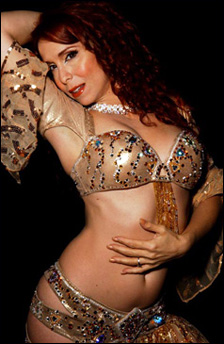Interview with Belly dancer Jillina
by SalomeJillina is best known as performer and Artistic Director for the Bellydance Superstars and choreographer of the Desert Roses. Prior, Jillina founded (and directs) the Award winning Sahlala Dancers. She has earned numerous awards from IAMED and the Giza Academy, including "Best Modern Egyptian Dancer", "Best Instructional Video", "Best Dance Company" and "Dancer of the Year". Jillina co-produced a line of instructional videos, and has traveled the world teaching seminars and performing in concerts.

Salome: Can you share a bit about your beginnings (when and how you were exposed to Oriental dance) and of your career leading up to the BDSS?
Jillina: I've been dancing most of my life. In the beginning I was doing Jazz and Hip Hop. Then I discovered belly dance and became completely obsessed with it, the music, the movements and self expression. From there I continued to study and began traveling to Egypt annually to study with master teachers like Raki Hassan, Mahmoud Reta, Fereda Fagmeh, and also to watch all of the great performers like Dina, Luci, Fifi Abdoud and many other Egyptian stars.
Then I started my own company a couple of years later, the Sahlala dancers. I wanted to take belly dancing to another level and I was inspired by some of the big shows that I had seen in Egypt and I created a dance company of my own and performed with them and also started teaching and traveling all over the world doing seminars and performing.
Then Miles Copeland approached me about directing and performing in Bellydance Super Stars and of course it is a great opportunity and I am currently working with both companies as well as teaching all over the world giving seminars.
Salome: Your costume wardrobe reflects the favored gowns and bedlah of Egyptian style but you have many avant garde pieces as well. Who designs your costumes, what is essential in your personal costuming flavor and what influences do you draw from?
Jillina: Some of my costumes I have made in Egypt and others I design myself with my seamstress here in L.A. It is wonderful working with Larisa, she comes from a ballroom dance background and has a lot of experience in costuming. As far as my inspiration I sometimes have a vision of a costume and come up with some crazy ideas or I might just go down and look for fabric, find a color and texture of fabric that inspires me to create something. That is one of the things I love about this dance, the individuality and being able to choose and design your own costumes is one of the wonderful aspects of this art form.
Salome: What are your thoughts on creating a universal movement vocabulary for Oriental dance, and/or certification system?
Jillina: As far as my thoughts on having universal vocabulary and certification systems, I think it's a great idea it would make studying this dance easier for new and upcoming students but I think it is definitely a challenge and I am not sure it can be done. My thoughts would be that possibly the names of the movements would be in Arabic. For example instead of shimmy it would be "Rasha" but then again how would we teach Turkish dance if everything was in Arabic. I like the idea but I don't know if it would be possible and it might limit this dance form in some ways. As a teacher it would make teaching a lot easier if we had a common ground. For example ballet has terms for movements and no matter where you go in the world if you say plie or grand jete everybody knows exactly what the movement is. So it's a great idea but I am not sure if it can be done.
Salome: When the subject of Americans performing Egyptian Raks Sharki comes into play there is a prevalent accusation that 'we' tend to be focused on technique rather than essence and native feeling. Do you think this is a truism generally or personally? Do you think some measure of Americanization dilutes the dance or adds a different type of richness and why?
Jillina: I think it's important to have both skills, both technique and emotion are very important to this art form. One thing I think westerners may lack is a better understanding of the music, instrumentation as well as the meaning of the songs. I think it is important to create emotion by understanding the music a little bit better. For example if you saw a Japanese dancer performing to a very sad piece of music in English and the dance did not reflect that mood it would not connect with the audience emotionally if the audience understands the words to the song. In the same way it is important for westerners to study and translate their songs and have a deeper understanding of the music so that they can connect with the audience and translate that to their audience.
I think one of things I like about the Americanization of belly dance is at times there is no limits - we can think outside the box. It doesn't have to be Egyptian, Tribal, or Cabaret we can use influences from all dance forms from around the world and create our own version of bellydance. I think it's a wonderful and creative process and I truly enjoy watching artists who do this but then it also must be cohesive with the music and costuming. It must have a flow and make sense artistically but it is one of the things that I embrace of this art form. A teacher told me once "Once you know the rules then you are allowed to break them".